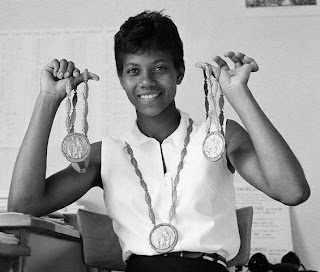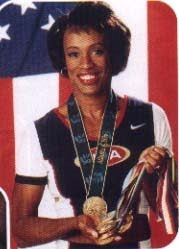The best Place in The World
(No comments)
The best Place in The World - It’s summer camp, a phenomenon invented by a Prussian and now quintessentially American. AMITY SHLAES remembers Camp Martin Johnson and has the scar to prove it.
Our 13-year-old likes a lot of things: his Wacom Graphire set, a session of pick-up soccer on the street after dinner. But the thing he likes most is his summer camp. September, November, March are all fine months, but to him they are just wait time until he can get underwater in McWain Pond at “the Rock”—his camp, Birch Rock (shown in photographs here).
Visiting day his second summer he stood behind a large outdoor hearth and before a group of parents on log benches and told an embarrassing little parable. “My life at home is like life in a harbor. At home there’s candy, and there are video games,” he said. But Birch Rock had changed him, he told his audience. He had realized that “a harbor is not what a ship is for.”
I share his enthusiasm. I once crafted a whole radio commentary—ostensibly about teen employment, I believe—all for the sake of getting a single sentence onto the air: “Birch Rock Camp in Waterford, Maine, is the best place in the world.”
My son and I are not alone. Camps are important to Americans—so important that some are more loyal to their camps than to their jobs, schools, or churches. The American Camp Association accredits more than 2,400 of them, and many more are unaccredited. There are day camps, weekend camps that offer hours in the batting cage, chess camps, weight-reduction camps, and family camps that teach togetherness by demonstrating the construction of s’mores. (Build tower of graham cracker, Hershey bar, and marshmallow; toast over campfire.)
In a few families, three or four generations have already known the experience of going eye to eye with those tiny “skeeter bugs” zipping across the water’s surface, of making their way across pine needles to a dark bathhouse, of sleeping in an odiferous cabin with, when possible, a raccoon underneath.
For many of us, sleep-away camp is the first and most important attempt at utopia, a better life outside of life. Some Americans become lifetime campers, smoothly transitioning from first-session newbie to archery instructor in a matter of eight or ten years. New England is home to a number of such people, many of whom have worked up and down the East Coast.
Europeans, and you will meet with polite incomprehension. Oddly enough, many French think their long breaks are for spending with their children. The British have their boarding schools, of course, but the tradition of summer camp is insignificant.
 Often, American camps have a charismatic hero in their past, such as Frank Barger at Camp Shohola in the Poconos in the 1950s, and John Benjamin Schamus at Raquette Lake Camp in upstate New York in the 1930s. Birch Rock’s mystical head, William Brewster, died around the time camp was scheduled to open for the summer in 1973, and Birch Rockers still talk about a birch tree that withered that same year.
Often, American camps have a charismatic hero in their past, such as Frank Barger at Camp Shohola in the Poconos in the 1950s, and John Benjamin Schamus at Raquette Lake Camp in upstate New York in the 1930s. Birch Rock’s mystical head, William Brewster, died around the time camp was scheduled to open for the summer in 1973, and Birch Rockers still talk about a birch tree that withered that same year.
Today’s European indifference is odd since the idea of a summer community of children led by an inspirational figure comes from Europe. The Prussian educator Friedrich Ludwig Jahn took German youth into the woods of Brandenburg to teach character and gymnastics. As the best directors do at today’s modern camps, Jahn was also shaping character. He wanted to give Germany parliamentarians who would be “not a pack of yes men and sycophants, not an assembly of rubber stamps convened to gloss over an evil.”
The first great American camper was Frederick William Gunn, who founded the Gunnery School for Boys in Washington, Connecticut, in the bucolic northwestern corner of that state. In 1861, around the time of the First Battle of Bull Run, Gunn led his students on a 40-mile walk to the beach at Milford, where they pitched tents. Later came hundreds of more established camps. The low price of property from Idaho to northern Michigan and the great woods of Canada made it possible for teachers and small schools to buy a lakeside plot upon which to plant their small society. In Maine—I happen to have become a Maine-o-centric camp mother—old farms begged for buyers, and camp owners complied.
Many of the new camps had special traditions from the start. In the early years at Wyonegonic in Denmark, Maine, girls arrived by barge, like the boarders at Hogwarts in the Harry Potter novels. Some camps were restricted to boys or girls, Christians or Jews. Looking back through a modern lens, one might assume that camps, like suburbs, were fundamentally about exclusion: regular Kenilworths and Dariens.
In fact, however, many camps, even in the old days, were also about inclusion. In 1939, European refugees were settling in every large city in America, and one of the goals of the agencies managing these crowds was to help immigrant children acclimate. The solution: send the kids to summer camp. Spots for a thousand children were offered from Hawaii to Michigan to Maine. The writer Dorothy Kemble articulated the sentiment of the officials. Camps were “small democracies,” she wrote, and “perhaps nowhere else could these future American citizens get quite so true an introduction.”
Postwar camps were also a reflection of their times. I come from a neighborhood—Hyde Park on the South Side of Chicago—that drew hippies long before the 1960s.
Another favorite Chicago institution was Camp Martin Johnson, near Irons, Michigan, a YMCA camp. This was my original camp—I still have the scar on my left foot to prove it, a reminder of a wound that a kind nurse once patched with butterfly bandages. At CMJ in the 1960s, the default culture was “Indian”—my cabins were Mohican and Shawnee—and the general community goal, mostly successful, was racial integration. CMJ is now defunct, but its camper roster included Bryant Gumbel, David Mamet, and Natalie Cole. Natalie wrote later that her four summers at CMJ were what taught her to love palomino horses.
A review of the campscape suggests that camps break down into two types. The first supplies skill or thrill. These are the places with stables of jet skis and golf carts, traveling teams and soda machines. At such camps, kids tend to play to their own strengths, with adult encouragement.
One of the hippies favorite camps was Circle Pines, which involved a lot of peanut butter and digging with shovels to emphasize the 'superior advantage of cooperation as a way of life.'
The second sort of camp is about character building, just like in the movies. That means damp nights in a tent that may be inching down a slippery mountain, and hours playing sports that you are bad at. Institutions in this latter category don’t allow phone calls from home, email, or even iPods. These camps provide rewards only after demonstrations of self-discipline: kids must, say, pass a craft course to get their “knife rights.” Many children adore this sort of camp, mainly because the world it creates is so different from home. A good example is Echo Hill in Maryland, founded in 1915 and now run by the charismatic Peter Rice Jr. Campers, who affectionately call the place “Echo Nam,” live in tents, exposed to the elements, near Chesapeake Bay.
Most camps, of course, feature a mixture of both cultures. The sheer intensity of parental attention is evident in July when, on visiting day, the dust darkens the pristine sides of the rental Tauruses that turn onto the dirt roads as parents arrive.
“The parents—who often missed their sons more than the other way around—started snaking down the camp road right after breakfast,” recalls Josh Wolk, author of Cabin Pressure. The book recounts Wolk’s desperate attempt to recapture his youth by spending, at the age of 34, a summer teaching 11-year-olds the pike surface dive.
Later on visiting day, Wolk writes, “the waterfront was alive with parenting styles.” Some of the parents were very concerned to know whether their children would move up a swim group: they might quip, only half-kidding, “Tell you what—if you can get him to level five by the end of the year, there’s a brand new Mercedes in it for you!”
But to dwell on camping as a pedagogic tool is to miss the point here. Most campers do not see sleep-away in familial, sociological, or developmental terms. They see it as something so good that it deserves fierce protection.
Parents aside, non-campers—such as the locals who slice the pepperoni on pizza day—tend to respect this. “The outside world has kept its distance from Wyo,” a Wyonegonic staffer once explained to a newspaper—it wasn’t the other way. All we outsiders can really know is that campers know something we don’t. Theorize about the phenomenon too long, you will find it is already autumn, and you have missed that last sniff of lake air.(Source)
Our 13-year-old likes a lot of things: his Wacom Graphire set, a session of pick-up soccer on the street after dinner. But the thing he likes most is his summer camp. September, November, March are all fine months, but to him they are just wait time until he can get underwater in McWain Pond at “the Rock”—his camp, Birch Rock (shown in photographs here).
Visiting day his second summer he stood behind a large outdoor hearth and before a group of parents on log benches and told an embarrassing little parable. “My life at home is like life in a harbor. At home there’s candy, and there are video games,” he said. But Birch Rock had changed him, he told his audience. He had realized that “a harbor is not what a ship is for.”
I share his enthusiasm. I once crafted a whole radio commentary—ostensibly about teen employment, I believe—all for the sake of getting a single sentence onto the air: “Birch Rock Camp in Waterford, Maine, is the best place in the world.”
My son and I are not alone. Camps are important to Americans—so important that some are more loyal to their camps than to their jobs, schools, or churches. The American Camp Association accredits more than 2,400 of them, and many more are unaccredited. There are day camps, weekend camps that offer hours in the batting cage, chess camps, weight-reduction camps, and family camps that teach togetherness by demonstrating the construction of s’mores. (Build tower of graham cracker, Hershey bar, and marshmallow; toast over campfire.)
In a few families, three or four generations have already known the experience of going eye to eye with those tiny “skeeter bugs” zipping across the water’s surface, of making their way across pine needles to a dark bathhouse, of sleeping in an odiferous cabin with, when possible, a raccoon underneath.
For many of us, sleep-away camp is the first and most important attempt at utopia, a better life outside of life. Some Americans become lifetime campers, smoothly transitioning from first-session newbie to archery instructor in a matter of eight or ten years. New England is home to a number of such people, many of whom have worked up and down the East Coast.
Camp fanatics can recognize the bouquet of a Lake Winnipesaukee, a Lake George, or a Moosehead--blindfolded.What makes Americans so crazy about their camps? Talk reveille and uniforms to, say,
These lifers are advocates of the seven-week stay, regarding any shorter period as being for wusses. They are also personalities of Proustian discernment. Lake water to them is as wine to a sommelier. They speak of summer seasons—“the windy one,” “the year the loon tried to get on the dock”—as of vintages. And they can recognize the bouquet of a Lake Winnipesaukee, a Lake George, or a Moosehead—blindfolded.
Europeans, and you will meet with polite incomprehension. Oddly enough, many French think their long breaks are for spending with their children. The British have their boarding schools, of course, but the tradition of summer camp is insignificant.
 Often, American camps have a charismatic hero in their past, such as Frank Barger at Camp Shohola in the Poconos in the 1950s, and John Benjamin Schamus at Raquette Lake Camp in upstate New York in the 1930s. Birch Rock’s mystical head, William Brewster, died around the time camp was scheduled to open for the summer in 1973, and Birch Rockers still talk about a birch tree that withered that same year.
Often, American camps have a charismatic hero in their past, such as Frank Barger at Camp Shohola in the Poconos in the 1950s, and John Benjamin Schamus at Raquette Lake Camp in upstate New York in the 1930s. Birch Rock’s mystical head, William Brewster, died around the time camp was scheduled to open for the summer in 1973, and Birch Rockers still talk about a birch tree that withered that same year.Today’s European indifference is odd since the idea of a summer community of children led by an inspirational figure comes from Europe. The Prussian educator Friedrich Ludwig Jahn took German youth into the woods of Brandenburg to teach character and gymnastics. As the best directors do at today’s modern camps, Jahn was also shaping character. He wanted to give Germany parliamentarians who would be “not a pack of yes men and sycophants, not an assembly of rubber stamps convened to gloss over an evil.”
The first great American camper was Frederick William Gunn, who founded the Gunnery School for Boys in Washington, Connecticut, in the bucolic northwestern corner of that state. In 1861, around the time of the First Battle of Bull Run, Gunn led his students on a 40-mile walk to the beach at Milford, where they pitched tents. Later came hundreds of more established camps. The low price of property from Idaho to northern Michigan and the great woods of Canada made it possible for teachers and small schools to buy a lakeside plot upon which to plant their small society. In Maine—I happen to have become a Maine-o-centric camp mother—old farms begged for buyers, and camp owners complied.
Many of the new camps had special traditions from the start. In the early years at Wyonegonic in Denmark, Maine, girls arrived by barge, like the boarders at Hogwarts in the Harry Potter novels. Some camps were restricted to boys or girls, Christians or Jews. Looking back through a modern lens, one might assume that camps, like suburbs, were fundamentally about exclusion: regular Kenilworths and Dariens.
In fact, however, many camps, even in the old days, were also about inclusion. In 1939, European refugees were settling in every large city in America, and one of the goals of the agencies managing these crowds was to help immigrant children acclimate. The solution: send the kids to summer camp. Spots for a thousand children were offered from Hawaii to Michigan to Maine. The writer Dorothy Kemble articulated the sentiment of the officials. Camps were “small democracies,” she wrote, and “perhaps nowhere else could these future American citizens get quite so true an introduction.”
Postwar camps were also a reflection of their times. I come from a neighborhood—Hyde Park on the South Side of Chicago—that drew hippies long before the 1960s.
One of the hippies’ favorite camps was Circle Pines, which involved a lot of peanut butter and digging with shovels—at least according to my brother’s report, made while wolfing down steak upon his return each August. The official literature said Circles Pines was rather about instilling faith in the “superior advantage of cooperation as a way of life.”
Another favorite Chicago institution was Camp Martin Johnson, near Irons, Michigan, a YMCA camp. This was my original camp—I still have the scar on my left foot to prove it, a reminder of a wound that a kind nurse once patched with butterfly bandages. At CMJ in the 1960s, the default culture was “Indian”—my cabins were Mohican and Shawnee—and the general community goal, mostly successful, was racial integration. CMJ is now defunct, but its camper roster included Bryant Gumbel, David Mamet, and Natalie Cole. Natalie wrote later that her four summers at CMJ were what taught her to love palomino horses.
A review of the campscape suggests that camps break down into two types. The first supplies skill or thrill. These are the places with stables of jet skis and golf carts, traveling teams and soda machines. At such camps, kids tend to play to their own strengths, with adult encouragement.
One of the hippies favorite camps was Circle Pines, which involved a lot of peanut butter and digging with shovels to emphasize the 'superior advantage of cooperation as a way of life.'
The second sort of camp is about character building, just like in the movies. That means damp nights in a tent that may be inching down a slippery mountain, and hours playing sports that you are bad at. Institutions in this latter category don’t allow phone calls from home, email, or even iPods. These camps provide rewards only after demonstrations of self-discipline: kids must, say, pass a craft course to get their “knife rights.” Many children adore this sort of camp, mainly because the world it creates is so different from home. A good example is Echo Hill in Maryland, founded in 1915 and now run by the charismatic Peter Rice Jr. Campers, who affectionately call the place “Echo Nam,” live in tents, exposed to the elements, near Chesapeake Bay.
Most camps, of course, feature a mixture of both cultures. The sheer intensity of parental attention is evident in July when, on visiting day, the dust darkens the pristine sides of the rental Tauruses that turn onto the dirt roads as parents arrive.
“The parents—who often missed their sons more than the other way around—started snaking down the camp road right after breakfast,” recalls Josh Wolk, author of Cabin Pressure. The book recounts Wolk’s desperate attempt to recapture his youth by spending, at the age of 34, a summer teaching 11-year-olds the pike surface dive.
Later on visiting day, Wolk writes, “the waterfront was alive with parenting styles.” Some of the parents were very concerned to know whether their children would move up a swim group: they might quip, only half-kidding, “Tell you what—if you can get him to level five by the end of the year, there’s a brand new Mercedes in it for you!”
But to dwell on camping as a pedagogic tool is to miss the point here. Most campers do not see sleep-away in familial, sociological, or developmental terms. They see it as something so good that it deserves fierce protection.
Parents aside, non-campers—such as the locals who slice the pepperoni on pizza day—tend to respect this. “The outside world has kept its distance from Wyo,” a Wyonegonic staffer once explained to a newspaper—it wasn’t the other way. All we outsiders can really know is that campers know something we don’t. Theorize about the phenomenon too long, you will find it is already autumn, and you have missed that last sniff of lake air.(Source)
Label:
Most Popular





















